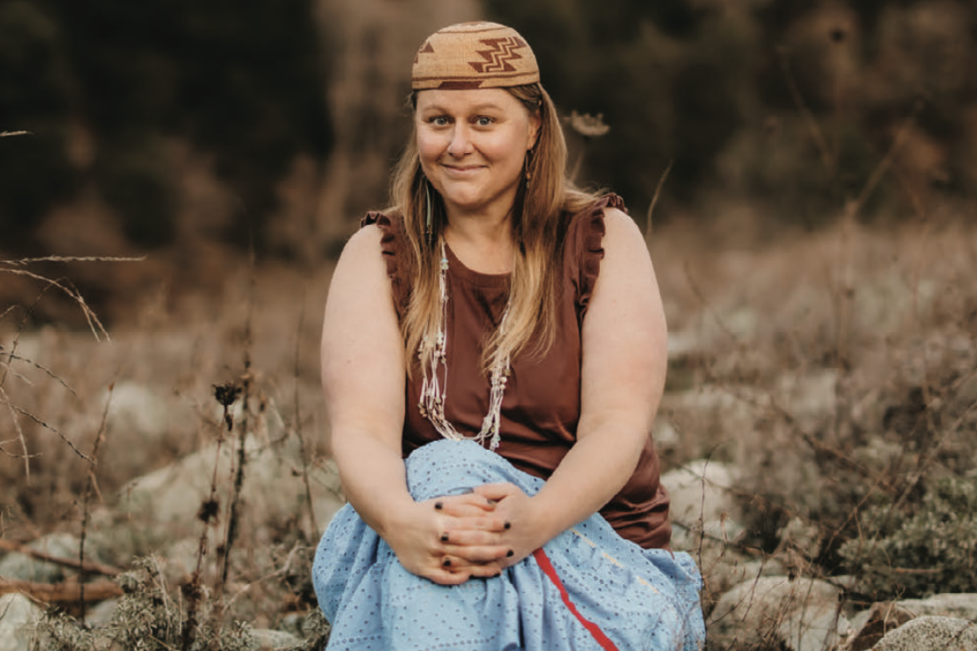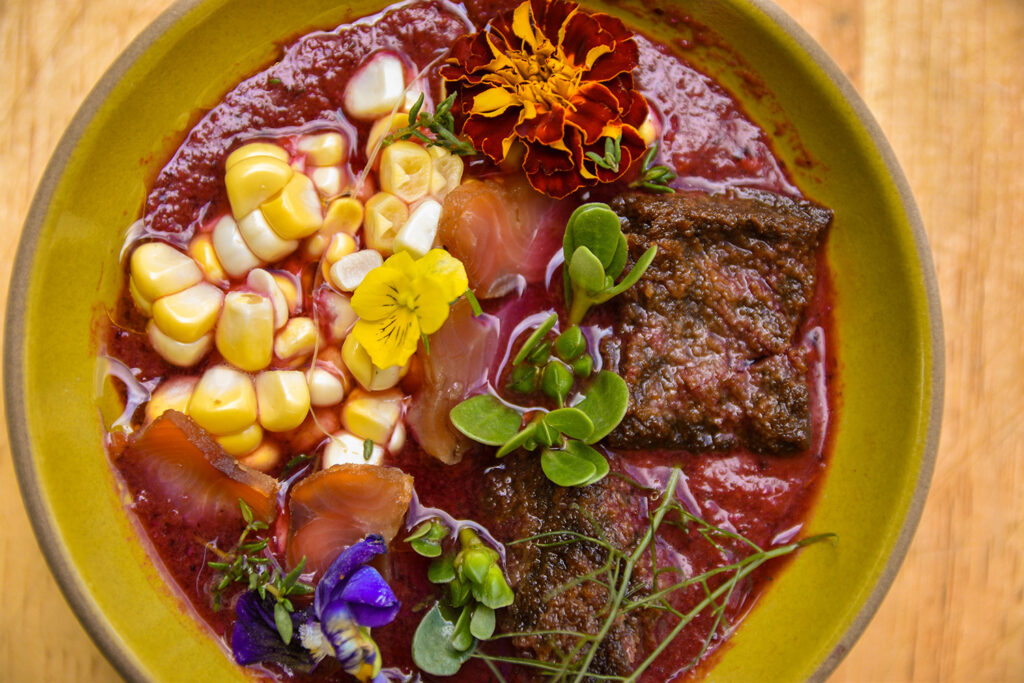Sara Calvosa Olson on Sustainable Food Gathering and Supporting Native Communities
Sheree Bishop, Communications Coordinator
November 15, 2024

Sara Calvosa Olson’s communal and reciprocal approach to cooking came from her parents, a Karuk mother and a Calabrese-American father, who raised her in a homesteading family on Hupa lands in what we now call Humboldt County.
During her childhood, food security came through her family hunting, gathering, and cultivating plants. Now, as a food writer and chef living on Huiman Coast Miwok Land, Sara shares recipes and advice inspired by her heritage, all compiled in her book, Chími Nu’am: Native California Foodways for the Contemporary Kitchen.
“Both of those cuisines are very community-oriented ways of cooking,” she says of her California Indigenous and Southern Italian roots. “You’re cooking for everybody. You’re cooking for your extended family. You’re thinking about your community. These are foods that are meant to nourish you, and that you can keep in your refrigerator over the week. It’s like ancient meal prep.”
Cooking for the Collective: Traditional Ingredients and Contemporary Cuisine
Sara’s cooking incorporates traditional Native ingredients into her contemporary recipes, such as deer meat dredged in acorn flour and cooked into a stew with acorn gravy, or sauce made with fermented fish caught in local bodies of water.
She says that her cooking also tends to lean toward Italian recipes and flavor profiles. In August 2024, Sara demonstrated one of her recipes, a Fig & Berry Gazpacho at the Foodwise Classroom, sourcing figs, blueberries, mushrooms, and other ingredients from the farmers market. When she made this recipe growing up, the ingredients were gathered to create a shareable meal, cooked in the Italian style with ingredients that are native to North America.
Chími Nu’am, which features seasonal guides and over 70 recipes, is meant to encourage its readers to develop a reciprocal relationship between themselves, the environment that sustains them, and the Native communities that steward this land. It inspires care and consideration of where our food comes from at every stage of the cooking process, from gathering ingredients to preparing or preserving them, to eating.
“It starts with us. We are the ones who begin the cycle of reciprocity. If you haven’t started from a place of service, and instead you’re going out and gathering without doing that service to Native communities first, then you are not actually participating in a cycle of reciprocity. It’s just extractive,” Sara says.

Gathering vs. Foraging: Decolonizing Your Mindset
One popular method of interacting with edible plants in the wild, especially when it comes to cooking, is known as gathering. Gathering is a means of subsistence in many Native communities, by which individuals or families collect what they need to survive. Resources that are gathered are often stored for later use and shared among the wider community.
In contrast, foraging generally refers to collecting wild plants for individual use or to sell for a profit. “A gathering mindset is different from a foraging mindset, which is ‘I’m going to go out and I’m going to take these things home and they’re just going to be for me’ or ‘I’m going to take as many as I can and I’m going to sell them,’” Sara says.
Because of this mindset, which has roots in colonization and colonial perception of “ownership” over Native lands, foraging results in taking food away from subsistence gatherers. It takes place without consent from the Native communities who have been stewarding, protecting, and gathering from that land for generations.
“Once those foods have been commodified, that money doesn’t stay in our communities, those foods don’t stay in our communities, and those foragers are not coming back year-round to help us tend these areas,” Sara says. “They’re not in community with Native people.”
Being in Partnership with Native Communities and Lands
Gathering without interfering with or extracting from Native communities also requires deferring to Tribal offices when trying to determine whether or not an area of land is off-limits. “Maybe there are places that are under restoration that will not benefit from disturbance. Checking in and finding out whose land you’re gathering on, and finding out what it is that you can do to be in service of them, that’s the place to start,” Sara says.
This means looking beyond gathering as a means to an end, such as cooking one meal or selling a product. Gathering, rather than foraging, encourages people to think about what their community can use, what they themselves will use a long time from now, and what will allow for the land to regenerate and remain viable enough for gathering for years to come.
“I do think that people who are into foraging have some calling to be out there and to do that work, but they just need to shift that foraging practice into thinking beyond their own homes and their own satisfaction at being on the land,” Sara says. “It’s about who will be on this land in seven generations, and who was on it before me, seven generations ago.”

Centering Curiosity About Your Food (and Decentering Colonialism)
Gathering, even for traditional and cultural purposes, is banned in a quarter of national parks. In others, the activity is highly restricted, even though all national parks sit on the overlapping territory of many Native tribes. Even when Native people are allowed to gather in national parks, this is limited as well, such as in 2019 when 11 Cherokee tribal members were allowed to gather only Sochan, known to non-Cherokee people as coneflower leaves. According to the Smithsonian Magazine, national park staff knew what coneflowers were, but did not know its Cherokee name or its cultural and culinary significance.
The gap between the colonial understanding of food and agriculture and the indigenous understanding of it is a direct result of centuries of suppression and erasure of Native communities. Sara insists that moving away from a colonial mindset means leaning into your curiosity when you eat. She encourages questions like, “Where do these foods come from? Are they being gathered and foraged on Tribal lands by people who have no connection or relationship to Tribal peoples?”
“When you’re increasing your knowledge and context for foods, it points out a stark contrast, like, ‘Why aren’t our agriculture systems set up to support the healthiest ways of eating and being? And once you start down those pathways, then you can start to see that these extractive systems aren’t meant to benefit the people,” Sara says.
Understanding the Native histories behind our food is the first step to combatting the continued effects of colonial violence, both psychological and physical.
“There’s Ohlone people fighting for land back and food sovereignty. There’s Coast Miwok people fighting for that as well,” Sara says. “Being in that mindset where you are open to decentering yourself or decentering settler colonialism and instead centering an Indigenous way of being in the world, in and of itself, is going to be quite an adjustment.”
Supporting Native Chefs
That adjustment can begin with supporting Native chefs, which includes both Native communities based in the Bay Area, and those who come from Native communities abroad. She recommends supporting Native-owned Bay Area restaurants such as Wahpepah’s Kitchen in Oakland and Cafe Ohlone in Berkeley. She also recommends Reem’s California because of the owner’s Palestinian heritage and her focus on sharing Palestinian cuisine, noting that Native people who are not from a Native American tribe are Indigenous as well.
“It all boils down to colonialism and not being able to survive in their colonial environment, and coming to a place where they might be able to take care of their families and make a living. And with them, they bring these Indigenous techniques, values, and worldviews,” Sara says.
For more ideas on how to develop a relationship with gathering, cooking, and eating that is more reciprocal with nearby Indigenous communities, check out Sara’s book, Chími Nu’am. You can also connect with Sara on Instagram or through her website.
Topics: Chef, Culinary, Environment, Food access
